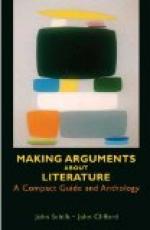Where the class is recognized as having definite characteristics or consequences, you can make your inference by showing that your case falls within the class. Sometimes the stress of your reasoning will come on making it clear that the consequence or characteristic on which your reasoning depends really belongs to the class. If, for example, you were arguing, as did the Class of ’85 at Amherst College, that your college should return to something like the old-fashioned classical education, you would try to establish the fact that men who have had the old-fashioned classical education are as a rule characterized by intelligence, liberal culture, and open-mindedness. In such cases it is the generalization on which the class is based which is the difficult part of your task.
In general, however, if you can show your readers that the present case belongs in a class of cases which can be recognized as belonging together by virtue of definable characteristics, you have established an excellent foundation for an inference based on those characteristics.
37. Reasoning by Causal Relation. Reasoning by generalization rises greatly in certainty, however, whenever you can show the workings of cause and effect. If a college receives every year from a certain school a number of boys who are slack and lazy students, the dean of that college may come to generalize and expect most of the boys from that school to be poor timber. If, however, he finds that the master of the school will take and keep any boy who lives in the town, he is able to argue from this as a cause to the conclusion that the standards of the school are low, and then from these low standards as a cause to the poor quality of the graduates of the school.
Here is another example, from Professor James:
I am sitting in a railroad car, waiting for the train to start. It is winter, and the stove fills the car with pungent smoke. The brakeman enters, and my neighbor asks him to “stop that stove smoking.” He replies that it will stop entirely as soon as the car begins to move. “Why so?” asks the passenger. “It always does,” replies the brakeman. It is evident from this “always” that the connection between car moving and smoke stopping was a purely empirical one in the brakeman’s mind, bred of habit. But if the passenger had been an acute reasoner ... [and had] singled out




